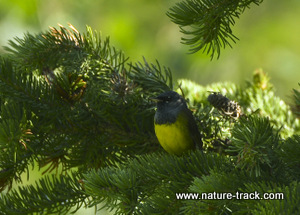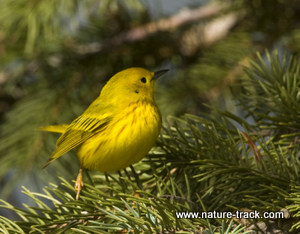Warblers

McGillivray’s warbler is a beautiful and common native bird that can be found in thick brush in clearings and alongside streams.

Yellow warblers are also common in our area and their yellow color make them very easy to see.
When my wife pointed out the tiny yellow-chested bird with the slate gray head I knew I had seen it before. Miles up a trail though, all I could do was snap a few photos to compare to the bird identification book when we returned to the truck. It turned out that the bird was a McGillivray’s warbler, a common bird in our area.
In the United States and Canada there are 56 species of warblers in eight families. But calling a bird a warbler isn’t always about blood-relationships. Some warbler families are closely related but others have developed from quite different parentage.
What all warblers share are body characteristics, a result of what scientists term convergent evolution. Similar characteristics develop in unrelated groups in comparable environments. For warblers, that means a small body, thin pointed bill, relatively short wings and a voracious appetite for insects. Most tend to prefer thick understory such as riparian areas but warblers can be found in just about any habitat type.
Some warblers are a little plain, but many are beautifully patterned. Yellow seems to be a predominant color among warblers. However, there are blue-hued warblers, black and white warblers and dramatic combinations of blacks, greens, grays and orange.
Given the name, warbler, one would expect all warblers to sing like opera stars. After all, the word, warbler, comes from the Old French word, werbler, which means, “to sing with trills and quivers.”
But even there, warblers aren’t all alike. Warblers are songsters, and some warblers are incredibly talented, singing complex melodic songs. But others have raspy trills that wouldn’t win them a spot on a rap music band.
Besides the McGillivray’s warbler, another popular warbler in this area is the yellow warbler. This beautiful, tiny lemon yellow bird with chestnut streaking on the male’s breast is one of the easiest of all birds to see and identify.
Warblers are some of the most migratory of species, spending much of the year in transit. They raise their young quickly and then begin to move toward winter habitat. Warblers migrate hundreds to thousands of miles finally settling down for a few months in southern states or even South America. Although much is yet to be learned, one thing researchers have learned is that many warblers don’t take the same route each time. Spring migration may be very different from fall migration.
Warblers are considered some of the most challenging birds to identify. Seasonal plumage changes, hybridization, female versus male, juvenile versus adult all increase the de-facto number of warbler “species” from 56 to hundreds.
Add to that their seemingly endless movement and they can torment even experienced birders. They can be such a challenge that a recent publication, The Warbler Guide, has been devoted to just these 56 species.
As a novice birder, I have learned a few of the easy warblers. But I can tell from the number I haven’t been able to identify, The Warbler Guide is going to make it to my bookshelf sooner than later.

"WOW. What a phenomenal piece you wrote. You are amazing." Jennifer Jackson
That is embarrassing, but actually a fairly typical response to my nature essays. Since The Best of Nature is created from the very best of 16 years of these nature essays published weekly in the Idaho Falls Post Register (online readership 70,000), it is a fine read. It covers a wide variety of topics including humorous glimpses of nature, philosophy, natural history, and conservation. Readers praise the style, breadth of subject matter and my ability to communicate complex and emotional topics in a relaxed and understandable manner.
Everyone can find something to love in this book. From teenagers to octogenarians, from the coffee shop to the school room, these nature essays are widely read and enjoyed.
Some of the essays here are my personal favorites, others seemed to strike a chord with readers. Most have an important message or lesson that will resonate with you. They are written with a goal to simultaneously entertain and educate about the wonderful workings of nature. Some will make you laugh out loud and others will bring a tear to the eye and warm your heart.
Readers Write:
"You hit a home run with your article on, Big Questions in Nature. It should be required reading for everyone who has lost touch with nature...great job!" Joe Chapman
"We enjoyed your column, Bloom Where Planted. Some of the best writing yet. The Post Register is fortunate to have your weekly columns." Lou Griffin.
To read more and to order a copy, click here or get the Kindle version
Copies are also available at:
Post Register
Island Park Builders Supply (upstairs)
Barnes and Noble in Idaho Falls
Harriman State Park, Island Park
Museum of Idaho
Valley Books, Jackson Wyoming
Avocet Corner Bookstore, Bear River National Wildlife Refuge, Brigham City, Utah
Craters of the Moon National Monument Bookstore, Arco, Idaho